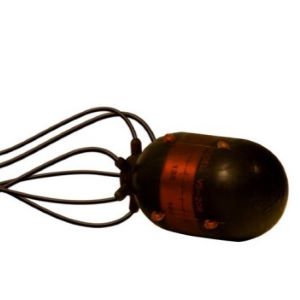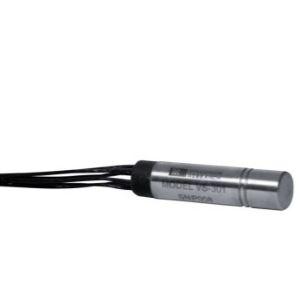Hydrophones
Hydrophones are underwater microphones for acoustic measurements. Wilcoxon Sensing Technologies hydrophones are built to withstand the rigors of continuous underwater exposure in both sea water and fresh water environments. Each hydrophone uses piezoelectric crystals with a built-in electronic amplifier, to boost the low level signal of pressure waves underwater signals. The output is a dynamic AC signal superimposed upon the DC Bias Output Voltage (BOV).
Typical applications
- Monitoring of underwater ordinance
- Ship noise studies
- Underwater biological studies
- Pump and machinery studies
New H23 series hydrophones
Next generation H23 series hydrophones are small, versatile, self-amplified, and shielded for a variety of underwater acoustic measurements.
Lab and ocean applications for the H23 series hydrophones include calibration, military surveillance, underwater biological studies, ship noise studies, pump cavitation and machinery studies, and monitoring of underwater ordnance. The hydrophone and cable entry are completely encapsulated in polyurethane to alleviates water intrusion caused by cathodic action. Pre-aged piezoelectric sensing elements promote long term stability.
H505L hydrophone
The H505L hydrophone is designed as a small, versatile, self-amplified hydrophone for use in a wide variety of underwater acoustic measurements. Ruggedness, low cost and an ultra low-noise internal amplifier are prime features of this model. The internal amplifier eliminates triboelectric cable noise, connector contamination problems and the requirement for an expensive in-line amplifier. The hydrophone and cable entry are completely encapsulated in polyurethane, preventing water intrusion caused by cathodic action. The assembly uses preaged piezoelectric (PZT) sensing elements.
- Sensitivity tolerance: -160.0 dB re 1V/µPa
- Low frequency: 2.0 Hz (120 CPM)
- High frequency: 10.0 kHz (600 kCPM)
- Maximum temperature: 80°C
- Designed to military specifications
Hydrophone models and specifications
Seismic sensors
Combine a supersensitive piezoelectric accelerometer, an ultra low-noise amplifier, and excellent electrical/mechanical isolation, and the result will be unmatched performance in measuring low-level vibration. Seismic accelerometers have internal amplifiers similar to industrial accelerometers. They are powered using the same method: a constant-current diode to provide power to the accelerometer. The seismic accelerometer amplifier output has a characteristic bias output voltage (BOV) and the vibration is superimposed upon this DC voltage level. The accelerometer circuit is isolated from the case, making installation and mounting simple, while the two-wire powering and signal method simplifies the wiring.
Wilcoxon seismic sensors are all characterized by good low frequency response, high output sensitivity and a low noise floor. They are primarily designed to measure low amplitude low frequency signals in applications such as structural monitoring and vibration isolation verification. Accelerometers used for earth seismic monitoring should have a very low noise floor. Model 731A has a noise floor very near the New High Noise Model (NHNM) developed by the U.S. Department of Interior. The 731A ultra-quiet seismic accelerometer can measure vibration levels down to the sub micro-g range by using an ultra low noise internal amplifier and a high sensitivity inertial sensing element. It contains no moving parts, is not sensitive to magnetic fields, and has a relatively low mass.
The P31 amplifier enhances the capabilities of the 731A by providing special low noise signal amplification and conditioning by providing 2.4 mA constant current needed to power the accelerometer’s internal amplifier.
Common applications
- Perimeter and road surveillance
- Border intruder detection
- Underground intruder detection
- Mine safety
- Vibration monitoring of bridges, buildings and towers
- Earthquake detection
- Geophysics, geothermal development
- Structural analysis
Seismic sensor models and specifications
Underwater accelerometers
Wilcoxon underwater accelerometers are designed to be used virtually anywhere under continuous submersion. They are built to withstand the high pressures of deep submergence. Titanium cases are used when the accelerometer must be highly resistant to galvanic corrosion or mounted on titanium structures. Stainless steel can be used for applications where the accelerometer will be mounted on cast iron or mild steel structures since they are near one another on the galvanic series list.
The ability to retain a hermetic seal while submerged is paramount for underwater accelerometers. All Wilcoxon underwater accelerometers are designed for continuous exposure to 650 PSI of water pressure. Helium leak testing is used to verify the hermeticity of the welding for accelerometers.
Underwater accelerometers models and specifications
Literature, specialized articles and publications
Advanced Sensing Technologies brochure
Our vector sensors have been mentioned in the following articles:
The following publications contain export-controlled information, which can only be released upon verification of recipient, end use and end user. To inquire, please email info@wilcoxon.com.
- A miniature vector sensor for line array applications
- The use of vector sensor for underwater port and waterway security
- SBIR success story
Export statement
Defense technologies and products are controlled for export purposes under the International Traffic in Arms Regulations (ITAR) 22 CFR parts 120-130 or the Export Administration Regulations (EAR) 15 CFR parts 700-799. For information on our technologies or products, we require verification of the recipient, end use and end user.
To inquire, please email info@wilcoxon.com.
International customers
An export license is required prior to provision of technology, products and services. To comply with all applicable export regulations, we may ask for further information or documentation prior to releasing any regulated technical information. Any information collected will be used solely for the purpose of compliance.
Product development capabilities
Engineering capabilities
- Finite Element Analysis (FEA) design and modeling
- Low power designs
- Digital interfaces
- High shock survivability
- Design to military specifications
Testing capabilities
- Noise measurements
- Shock survivability
- Underwater sensitivity, phase and directionality
- Magnetic heading and inertial pitch/roll calibrations
- Pressure and temperature
- Military standards: MIL-STD-461, MIL-STD-810, RTCA/DO-160
 ENGLISH
ENGLISH


























































